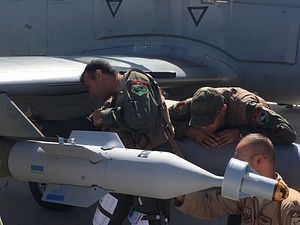The Afghan Air Force (AAF) used laser-guided bombs for the first time during a close air support mission in the province of Farah in southwestern Afghanistan on March 22, according to a March 27 statement by the NATO-led Resolute Support mission.
A squadron of AAF Embraer/Sierra Nevada Corporation A-29 Super Tucano light attack aircraft dropped a GBU-58 laser-guided bomb on a Taliban compound to support Afghan Army ground operations. “The drop resulted in a direct hit along the route of a major Afghan National Army clearing operation, marking the first time the AAF dropped a laser-guided bomb in combat,” the NATO statement reads.
The AAF pilots purportedly elected to employ the GBU-58 over an unguided bomb to avoid collateral damage. It is unclear whether any civilians were hurt in the attack. The A-29 Super Tucano can carry up to two 500-pound (226 kilogram) conventional or smart freefall bombs, in addition to short-range air-to-air missiles, machine guns and rockets. The aircraft constitutes the mainstay of Afghan air power.
“The A-29 Super Tucano is a turboprop aircraft specifically designed for counter-insurgency operations and can be equipped with a wide array of bombs (including precision guided munitions) and machine guns,” I explained previously. “The aircraft is fairly cheap to operate with one hour of flying time costing around $1,000.”
The U.S. Air Force has spent $427 million under its so-called Light Air Support/A-29 Afghanistan Program to supply the AAF with 20 A-29 aircraft by the end of this year. The AAF currently operates 12 aircraft with seven additional A-29 stationed at Moody Air Force Base in Georgia for pilot training. (One A-29 crashed during a test flight and still needs to be replaced.) The seven A-29s will be transferred to Afghanistan in the coming weeks.
Each A-29 costs around $18 million. In October 2017, the Pentagon ordered six additional A-29s for the AAF. “Production of these six new aircraft is to start immediately in Jacksonville, Florida and brings to 26 the total number of aircraft provided to the Program,” Brazilian aircraft maker Embraer Defense & Security announced in a statement at the time.
The AAF for the first time used GBU-58/B laser guided bombs on a training range in Afghanistan in December 2017. The March 22 attack “comes just three months after the AAF completed training to employ a laser-guided bomb,” according to the March 27 NATO statement. “AAF weapons personnel and crew chiefs loaded, armed, and launched the aircraft with minimal advisor input.”
The AAF currently consists of around 8,000 members and 129 aircraft in total.































